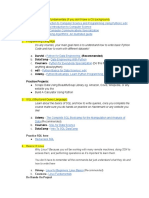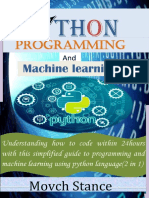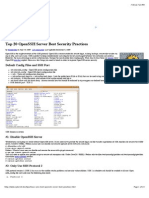Python AWS Data Engineering Course- Master PySpark, Kafka, SQL
Uploaded by
suresh pPython AWS Data Engineering Course- Master PySpark, Kafka, SQL
Uploaded by
suresh p🚀 Python AWS Data Engineering Course: Master PySpark, Kafka, SQL!
S3 ,Glue,
EMR, Athena, Kinesis, Lambda, Redshift
Python :- Learn about the python with an overview of all its relevant topics and tools
AWS Data Engineering Fundamentals**: Dive deep into the AWS cloud environment and
understand the core concepts of data engineering.
🐍 **PySpark Mastery**: Learn how to harness the full potential of PySpark for data processing
and analysis. Master PySpark to efficiently work with large datasets, perform transformations,
and build data pipelines.
💼 **SQL for Data Engineers**: Sharpen your SQL skills to manage and query data effectively.
Learn advanced SQL techniques for data manipulation, aggregation, and optimization.
📶 **Kafka Integration**: Explore the world of real-time data streaming with Kafka. Understand
how to set up Kafka clusters, publish and consume messages, and integrate Kafka with AWS
services
📊 **Hands-On Projects**: Apply your knowledge to real-world projects and gain practical
experience in data engineering on AWS.
📅 **Flexible Schedule**: Our course is designed to accommodate your busy lifestyle. Choose
from flexible online classes that suit your availability.
—-------- Python and pandas
1. Data Engineering for Everyone
Discover how data engineers lay the groundwork that makes data science possible. No coding
involved!
2. Python Basics
Learn about the python variable, Data types , Operation , conditional statement , Date operations
3. Writing Functions in Python
Learn to use best practices to write maintainable, reusable, complex functions with good
documentation.
4. Streamlined Data Ingestion with pandas
Learn to acquire data from common file formats and systems such as CSV files, spreadsheets,
JSON, SQL databases, and APIs.
5. Data Cleaning with pandas
Learn to clean messy data that executes quickly and allocates resources skillfully to avoid
unnecessary overhead.
6. Object-Oriented Programming in Python
Dive in and learn how to create classes and leverage inheritance and polymorphism to reuse and
optimize code.
7. Introduction to Automation with python
The Python command line helps users combine existing programs in new ways, automate
repetitive tasks, and run programs
—-------- AWS
1. **Introduction to Cloud**
Learn about AWS cloud technology to optimize your data workflow.
2. **Amazon S3 (Simple Storage Service)**
Understand how to use S3 for scalable object storage, data backup, and managing large
datasets.
3. **AWS Lambda**
Explore serverless computing with AWS Lambda, focusing on event-driven execution and
integrating with other AWS services.
4. **Amazon Athena**
Learn how to run interactive queries on data stored in Amazon S3 using Athena, and
understand its integration with other analytics tools.
5. **Amazon EMR (Elastic MapReduce)**
Discover how to process large datasets using Hadoop, Spark, and other big data frameworks
with EMR.
6. **AWS Glue**
Gain insights into data preparation and ETL (Extract, Transform, Load) processes with AWS
Glue, and how it facilitates data integration and cataloging.
7. **Amazon Redshift**
Learn about Redshift for data warehousing, including how to manage and analyze large
volumes of data efficiently.
This sequence prioritizes foundational tools and services before diving into specific data
processing and analysis technologies.
—-------- Pyspark
1. Introduction to PySpark
Learn to implement distributed data management and machine learning in Spark using the
PySpark package
2. Big Data Fundamentals with PySpark
Learn the fundamentals of working with big data with PySpark
3. Cleaning Data with PySpark
Learn how to clean data with Apache Spark in Python.
4. Introduction to Spark SQL in Pyspark
Learn how to manipulate data and create machine learning feature sets in Spark using SQL in
Python.
—------- SQL
1. Introduction to Relational Databases in SQL
Learn how to create one of the most efficient ways of storing data - relational databases!
2. Database Design
Learn to design databases in SQL.
3. Improving Query Performance in SQL Server
In this course, students will learn to write queries that are both efficient and easy to read and
understand..
—------ Kafka
1. **Introduction to Kafka in Python**
In this course, students will learn to use Kafka in Python in ways that are both efficient and
easy to read and understand.
2. **Kafka Architecture and Components**
Explore Kafka's fundamental components such as Producers, Consumers, Brokers, Topics,
and Partitions. Understand how these elements interact to provide a scalable and fault-tolerant
messaging system.
3. **Configuring and Managing Kafka**
Learn how to set up and configure Kafka clusters, including tuning performance, managing
topics, and ensuring data durability and availability.
4. **Advanced Kafka Features**
Delve into advanced Kafka functionalities such as stream processing with Kafka Streams,
integrating with Kafka Connect for data ingestion, and leveraging Kafka's security features for
authentication and authorization.
You might also like
- The Age of AI and Our Human Future (Henry Kissinger, Eric Schmidt Etc.) (Z-Library)100% (8)The Age of AI and Our Human Future (Henry Kissinger, Eric Schmidt Etc.) (Z-Library)148 pages
- Christopher Langan - CTMU, The Cognitive-Theoretic Model of The Universe, A New Kind of Reality Theory88% (8)Christopher Langan - CTMU, The Cognitive-Theoretic Model of The Universe, A New Kind of Reality Theory56 pages
- Data Structure and Algorithmic Thinking With Python Data Structure and Algorithmic Puzzles PDF95% (20)Data Structure and Algorithmic Thinking With Python Data Structure and Algorithmic Puzzles PDF471 pages
- Gayle Laakmann McDowell - Cracking The Coding Interview - 189 Programming Questions and Solutions (2015, CareerCup)81% (48)Gayle Laakmann McDowell - Cracking The Coding Interview - 189 Programming Questions and Solutions (2015, CareerCup)708 pages
- Cracking The Coding Interview - 189 Programming Questions and Solutions (6th Edition) (EnglishOnlineClub - Com)100% (10)Cracking The Coding Interview - 189 Programming Questions and Solutions (6th Edition) (EnglishOnlineClub - Com)708 pages
- Gödel, Escher, Bach - An Eternal Golden Braid (20th Anniversary Edition) by Douglas R. Hofstadter (Charm-Quark) PDF100% (10)Gödel, Escher, Bach - An Eternal Golden Braid (20th Anniversary Edition) by Douglas R. Hofstadter (Charm-Quark) PDF821 pages
- Chris Bailey - Hyperfocus - The New Science of Attention, Productivity, and Creativity-Viking (2018)100% (25)Chris Bailey - Hyperfocus - The New Science of Attention, Productivity, and Creativity-Viking (2018)306 pages
- The Art of Asking ChatGPT For High-Quality Answers A Complete Guide To Prompt Engineering Techniques (Ibrahim John) (Z-Library)100% (24)The Art of Asking ChatGPT For High-Quality Answers A Complete Guide To Prompt Engineering Techniques (Ibrahim John) (Z-Library)52 pages
- Cs 229, Autumn 2016 Problem Set #2: Naive Bayes, SVMS, and TheoryNo ratings yetCs 229, Autumn 2016 Problem Set #2: Naive Bayes, SVMS, and Theory20 pages
- venu-Data-Engineering-training-in-hyderabad-1No ratings yetvenu-Data-Engineering-training-in-hyderabad-18 pages
- Becoming A Data Engineer (The StudyPlan)No ratings yetBecoming A Data Engineer (The StudyPlan)4 pages
- NDS Data Practitioner Degree CurriculumNo ratings yetNDS Data Practitioner Degree Curriculum10 pages
- Diploma in Data Science Online Training Content by MR Navin NareshIT ModifiedNo ratings yetDiploma in Data Science Online Training Content by MR Navin NareshIT Modified10 pages
- Data Engineering Nanodegree Program Syllabus PDFNo ratings yetData Engineering Nanodegree Program Syllabus PDF5 pages
- Certification in advanced Python, R and Data Management 18.12.24No ratings yetCertification in advanced Python, R and Data Management 18.12.246 pages
- Data Engineering Roadmap For Freshers & ResourcesNo ratings yetData Engineering Roadmap For Freshers & Resources6 pages
- Advance Big Data Science Using Python-R-Hadoop-Spark (1/3) : Total Duration: 90 Hours + PracticeNo ratings yetAdvance Big Data Science Using Python-R-Hadoop-Spark (1/3) : Total Duration: 90 Hours + Practice1 page
- Kafka Up and Running for Network DevOps: Set Your Network Data in MotionFrom EverandKafka Up and Running for Network DevOps: Set Your Network Data in MotionNo ratings yet
- Big Data on Kubernetes: A practical guide to building efficient and scalable data solutionsFrom EverandBig Data on Kubernetes: A practical guide to building efficient and scalable data solutionsNo ratings yet
- Roadmap How To Learn AI in 2024 (Uncovered AI)No ratings yetRoadmap How To Learn AI in 2024 (Uncovered AI)6 pages
- Python Programming and Maching Learning 2 in 1 B08Y5DPX32100% (7)Python Programming and Maching Learning 2 in 1 B08Y5DPX32145 pages
- Current and Future Trends on AI Applications - Mohammed A Al-SharafiNo ratings yetCurrent and Future Trends on AI Applications - Mohammed A Al-Sharafi456 pages
- Access Control Terminal Installation Guide PDFNo ratings yetAccess Control Terminal Installation Guide PDF2 pages
- Journal of Economics, Finance and Management Studies: Aulia Rahma Yeni, Monica Weni PratiwiNo ratings yetJournal of Economics, Finance and Management Studies: Aulia Rahma Yeni, Monica Weni Pratiwi6 pages
- 3D Strutural Analysis of Crack Risk in Hardening ConcreteNo ratings yet3D Strutural Analysis of Crack Risk in Hardening Concrete101 pages
- LM107/LM207/LM307 Operational Amplifiers: General DescriptionNo ratings yetLM107/LM207/LM307 Operational Amplifiers: General Description10 pages
- Practical Electronics 1966 11 S OCR2 PDFNo ratings yetPractical Electronics 1966 11 S OCR2 PDF70 pages
- Top 20 OpenSSH Server Best Security PracticesNo ratings yetTop 20 OpenSSH Server Best Security Practices10 pages























































































































